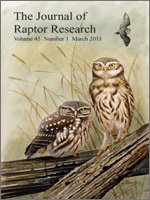The sex determination of Eurasian Sparrowhawks (Accipiter nisus) is not apparently a problem, as sexual dimorphism seems to be evident, at least in adults. However, there is a clinal geographic variation expressed as increasing size and decreasing color saturation from west to east. Hence, in wintering regions such as the Iberian peninsula, where migrant birds headed toward Africa also occur, sedentary birds are mixed with migrant and wintering birds from September to April. Here, we would expect to find birds from different breeding areas and therefore, possessing notable differences in biometrics, body mass, or color. We trapped eighteen adult sparrowhawks during the breeding seasons between 2001 and 2007 in Bizkaia, northern Spain, and we measured 91 dead and 38 rehabilitated sparrowhawks from Spanish Wildlife Rehabilitation Centers (WRC) between 1999 and 2007. A total of 147 full-grown sparrowhawks were sexed, aged, and measured. Some overlap between sexes was found for all but four measurements (eighth primary length [P8], wingspan, forearm, and mass). Only bill length differed significantly between age classes (juvenile/adults) and wingspan differed between sedentary and wintering birds for both sexes. Three variables: bill length, forearm, and P8 were retained in the discriminant function, allowing us to determine the sex with 100% accuracy. It is possible to correctly sex sparrowhawks, both adults and juveniles, using the three measures, even when the origin of the bird is unknown.
How to translate text using browser tools
1 March 2011
Sex Determination in Eurasian Sparrowhawks (Accipiter nisus)
Iñigo Zuberogoitia,
Raúl Alonso,
Luis E. Palomares,
Jose Antonio Martínez

Journal of Raptor Research
Vol. 45 • No. 1
March 2011
Vol. 45 • No. 1
March 2011
Accipiter nisus
Biometry
discriminant function analysis
Eurasian Sparrowhawk
Morphometrics
reversed sexual dimorphism (RSD)
sexing




